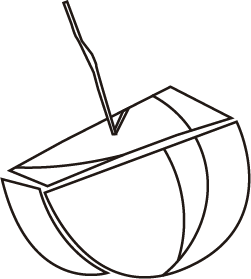THE GALLINERA CASTLE
 The Castle of Gallinera, or Benirrama, is located at the eastern entrance to the valley. It sits on a rocky mound next to the Almiserà peak, at 475.6 metres above sea level. The name that history has given it is Gallinera Castle, but in La Vall de Gallinera it is more commonly known as Benirrama Castle.
The Castle of Gallinera, or Benirrama, is located at the eastern entrance to the valley. It sits on a rocky mound next to the Almiserà peak, at 475.6 metres above sea level. The name that history has given it is Gallinera Castle, but in La Vall de Gallinera it is more commonly known as Benirrama Castle.
The historical function of the castle was to monitor and defend the entrance to the valley from the plains next to the sea.
It is an elongated castle, with the main axis, which is oriented northeast to southwest, measuring more than 150 metres, with a maximum width of 33 metres.
It has a main area at the highest point where a keep with a rectangular floor plan is located, and where there is also a cistern. This bastion is oriented towards the west and has a rectangular area protected by new constructions that insulate it and make it gain in height.
The rest of the castle space consists of a large courtyard with two cisterns, one at each end.
The defensive constructions are formed by a long wall with battlements that surrounds the whole mound and has six towers.
The access door, located under a rectangular masonry tower, opened on the east side. This tower and the wall beginning from the tower were connected by an arch to the wall on the left, forming an easy-to-defend entrance corridor.
Masonry predominates, with considerable extensions of the walls having been made with opus vitatum facing west, while the rest was made using opus incertum.
There are remains of a rammed earth wall next to the keep, as well as a long wall with parapets.
The first written record of “Ghallinayra Castle” dates from 1245, with the signing of the Pouet Pact between the heir Alfonso and al-Azraq. In 1247, during the first uprising, this castle was taken by al-Azraq’s Saracens. On the 1st of June, 1258, the castle was recaptured by King Jaume I, who, starting in 1261, ceded it in turn to various people in order to cover his debts with them. On the 22nd of June, 1322, Jaume II donated the castle to his fourth son, the heir Pere d’Aragó, count of Ribagorça. This donation put an end to the royal possession of the district of Gallinera, which then became a feudal manor. From then on, the castle was included, during a whole century, in the great feudal manor of the county of Dénia and of the royal dukes of Gandia, until 1424, when it returned to the royal patrimony. Guillem de Vich received it in 1425 and, some years later, in 1487, Miquel Hieroni de Vich sold La Vall de Gallinera, with the castle, to Pere Lluís de Borja for 199,000 sous. The earthquake of 1644 destroyed it permanently, although by that time the castle had already been uninhabited for some years (Torró, 1985; Rubio, 1986; Guinot, 2007).
Bibliography:
GUINOT, E. (2007): L’escenari de les senyories medievals a la comarca de la Marina Alta, II Jornades d’Estudis Carmel Giner Bolufer de Pego i les Valls, Ajuntament de Pego, 2006, pp. 83-110.
RUBIO, F. (1986): Castillo de Gallinera, Arqueología en Alicante 1976-1986. Instituto de Estudios Alicantinos Juan Gil Albert. Diputación Provincial de Alicante 1986. pp. 41-42.
RUBIO, F. (1988): Catálogo de yacimientos de materiales altomedievales y musulmanes, L’Ull del Moro, Alcoi.
TORRÓ, J. (1985): Torres i Castells de l’Alcoià-Comtat, Congrés d’Estudis Alcoià-Comtat.
SOLAZ, V.; BOHIGUES, C. (1983): Arquitectura hispano-musulmana en la Vall de Gallinera. Inèdit.







